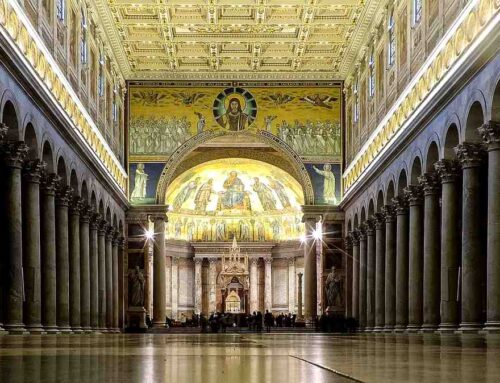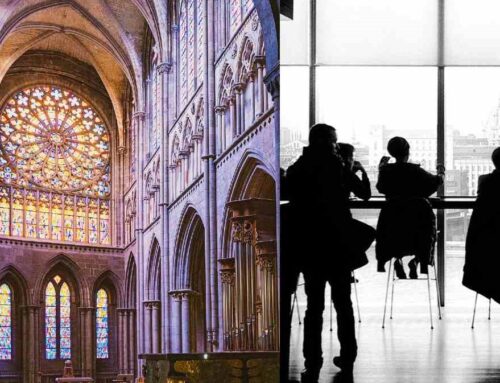
Homily preached by the Reverend Peter M. J. Stravinskas, Ph.D., S.T.D., at the Church of St. Mark in Highlands Ranch, Colorado, on the Fifth Sunday in Lent (Year A), during the weekend of March 25-26, 2023.
We have heard a lot over the years about people who have supposedly experienced death and have, somehow or other, come back to life. Today we meet one such gentleman in the gospel—Lazarus. What is the point of reading this Gospel on this particular Sunday?
First of all, St. John constructed his Gospel in such a way that we encounter Jesus working six signs, each one building in importance until we reach the sixth and greatest—the raising of Lazarus from the dead. John wanted to show the connection between the work of Christ and the work of God the Father at the dawn of Creation, for Jesus was bringing about a “New Creation.” John also used this Lazarus episode as a kind of sneak preview of Our Lord’s own Resurrection. But I think the Church wants us to consider Lazarus in the tomb and to ask ourselves if we are not in some way like him.
Each of us lives in his own private tomb so often. Like Lazarus, we are bound head and foot by our faults and sins, which keep us from living full Christian lives. Am I unconcerned about the welfare of others? Am I addicted to alcohol, or gambling, or sex, or pornography, or drugs? Am I mastered by the spirit of materialism abroad in the world today? Do I seek to dominate others? Have I been intimidated into silence by the radical secularists in our midst? If so, I am among the living dead, and today, Jesus summons me to come forth from the tomb of my personal sinfulness with all the force He used in raising Lazarus, as He says: “Peter, Anne, Mary, Joe . . . Come out!”
How can I share in this Lazarus event? By opening myself to the Word of God, by a change of heart, by using this Lenten season as a time of self-examination and growth, by adopting a new course and direction in my life, and by returning to the Lord and the community of the Church through the Sacrament of Penance. That is, by claiming the grace made available through Christ’s saving Death and Resurrection. Jesus wants us all to be a part of His “New Creation,” but belief in Him and lives of sin are incompatible, so we must heed the Lord’s call to follow Him and make Him the focus of our lives and love. Our Divine Savior is just as eager to do for each one of us what He did for Lazarus, and we will hear Him say those same powerful and comforting words: “Untie him and let him go free!”
I have also been invited to speak to you today by your pastor about some exciting possibilities affecting the future of your parish, namely, the capital campaign enabling you to build a new church, adoration chapel, and parish school. Coming from the Northeast as I do, where we are suffering a demographic winter, I find it exhilarating to contemplate building rather than closing – new life rather than death!
This is surely a most ambitious project, however, your pastor, whom I have known for a number of years, is certainly up to the task. Frankly, most priests would shy away from such an endeavor; Father Bierbaum, on the other hand, has embraced it. I trust that his vision, enthusiasm and leadership will motivate all of you. Many years ago, St. Mother Teresa of Calcutta declared that her mission in life was “to do something beautiful for God.” You parishioners of Saint Mark’s today are being given a once-in-a-century opportunity “to do something beautiful for God.” Let me spell that out in some detail.
Truth be told, God doesn’t need a splendid church building, but we do. What do I mean? When we are concerned with the things of God, only our finest will do. Isn’t that the lesson we learn at the very beginning of salvation history through the story of Cain and Abel as Cain offered his second-best, while his brother offered his best? Further, in constructing a church that most mirrors our Catholic tradition of inspiring and even breath-taking architecture, we give glory to God as those outside the family of the Church are led to know of our love for our Creator and Lord. At the same time, such a church raises our minds and hearts to God in a unique fashion. Bring a five-year-old into a Gothic church. What’s his reaction? With a wide-open mouth, he exclaims, “Ah!” Bring the same child into a Motel-6 church? He moves on without a word.
Aristotle teaches us that the human person is brought into contact with eternity through the Good, the True, and the Beautiful. Sometimes, in our efforts to evangelize the unchurched, we attempt to convince the person to live a good life or to accept the truths of the Faith. I would suggest those might be the wrong starting-points. Many years ago, while working often at a university, I came to know a young architecture major dating a devout Catholic girl. While never opposed to Catholicism, he wasn’t particularly enamored of it, either. Upon graduation, his parents gave him the gift of a month in Europe. Upon his return, he called me and announced that he wanted to become a Catholic. “Why now?” asked I. “Father, any religion that can produce that much beauty has to be the true religion.” Beauty brought him to accept the truth which, in turn, enabled him to desire to live a good and holy life. I would submit that the church building being proposed for your parish community is one that will not only put each of you more easily into contact with the Holy but will also serve as a silent but most effective vehicle of evangelization for the curious or even the seemingly closed.
Part of the plan is the construction of a Eucharistic adoration chapel, which will be a place where Our Blessed Lord will be available, on demand, as it were, 24-7, waiting to receive your prayers of adoration, contrition, thanksgiving and supplication. St. John Paul II, in Mane Nobiscum, Domine, his 2004 apostolic letter and a kind of last will and testament of his, wrote the following gripping words: “The presence of Jesus [in the Holy Eucharist is] a kind of magnetic pole attracting an ever greater number of souls enamored of him, ready to wait patiently to hear his voice and, as it were, to sense the beating of his heart” (n. 18). The Holy Father also sought to shake us out of our Eucharistic complacency into what he termed a genuine “Eucharistic amazement,” which has particular relevance for the Church in the United States as we – hopefully – are participating in the “Eucharistic revival”:
The Year of the Eucharist has its source in the amazement with which the Church contemplates this great Mystery. It is an amazement which I myself constantly experience. It prompted my Encyclical Ecclesia de Eucharistia. As I look forward to the twenty-seventh year of my Petrine ministry, I consider it a great grace to be able to call the whole Church to contemplate, praise, and adore in a special way this ineffable Sacrament. May the Year of the Eucharist be for everyone a precious opportunity to grow in awareness of the incomparable treasure which Christ has entrusted to his Church. May it encourage a more lively and fervent celebration of the Eucharist, leading to a Christian life transformed by love. (n. 29)
Your future adoration chapel will facilitate just such an awareness.
Last but by no means least will be the construction and opening of a parish school. In the interests of full disclosure and transparency, I must state unequivocally that this is the dearest aspect of the entire project to my heart – the capstone of it all, in my estimation. I began working in the Catholic school apostolate as an 18-year-old seminarian and although I have had numerous responsibilities as a priest, none has brought me more satisfaction than working on behalf of our beloved Catholic schools. You see, when my parents committed their only child to the parish school of St. Rose of Lima in Newark, New Jersey, way back in 1955, not only had they never gone to a Catholic school themselves, but they were not married in the Church, and probably hadn’t been to Mass since their Confirmation. It was in that school, however, that I received not only my faith but the gift of my vocation to the Sacred Priesthood and, by a process I like to call “reverse evangelization,” I brought my parents back to Christ and His Church. That still happens today.
In the nineteenth century, when the bishops of our nation began the adventure of the Catholic school system – unique in the history of the Church – they firmly believed that without our own schools, the youth of the time would be lost to the Church through the assaults of a vicious anti-Catholicism promoted through the so-called “public” schools. In our own time, those assaults are even more pernicious, coming through the thoroughly pagan and virulently hostile, godless schools as children are exposed to every kind of perversion and lunacy imaginable. Indeed, a recent study revealed that the average Catholic child in a government school loses his or her faith by the fourth grade! On the other hand, I would invite you to consider these facts:
Millennial Catholics who attended Catholic schools are seven times more likely to attend weekly Mass than millennial adults who attended public schools (Gray, 2014).
Some 51% of those ordained to the priesthood attended Catholic grade school and 43%, a Catholic high school (Ference, 2015).
Men who have attended a Catholic secondary school are more than six times as likely to consider a vocation (NRVC, 2013).
Women who have attended a Catholic primary school are three times as likely to consider being a religious Sister (NRVC, 2013).
Catholic school students are more likely to pray daily, attend church more often, retain a Catholic identity as an adult, and are faithful stewards (Sander, 2001).
I suspect that a show of hands would demonstrate that a sizable majority of you are the products of Catholic schools.
Let me hasten to add that the building and maintenance of a Catholic school is not the sole or even primary responsibility of parents enrolling their children there; according to the teaching and law of the Church, it is the responsibility of the entire Catholic community. Therefore, the engagement of every parishioner is expected and needed, that is, if we are committed to the survival and growth of the Church in our own place and time. The great English convert of the nineteenth century, St. John Henry Cardinal Newman (Reply to Abp. Vaughn, 11/16/1879), offered this stark assessment:
It is indeed the gravest of questions whether our people are to commence life with or without adequate instruction in those all-important truths which ought to colour all thought and to direct all action; – whether they are or are not to accept this visible world for their God and their all, its teaching as their only truth, and its prizes as their highest aims; – for, if they do not gain, when young, that sacred knowledge which comes to us from Revelation, when will they acquire it?
Yes, if not “when young,” then “when”?
You may recall that St. John Paul often referred to Catholic schools as the very “heart of the Church.” I can assure you that St. Mark’s School (that has a nice ring to it, doesn’t it?) will be the very “heart of your parish,” enlivening it with youthful joy and promise.
I should also note that, given the abysmal state of public education, our Catholic schools will be providing the only seriously formed players for the foreseeable future, both academically and morally. During Pope Benedict XVI’s 2008 visit to Washington, D.C., he delivered a stirring address to Catholic educators, in which he asserted that Catholic schools “nurture the soul of a nation.”
Finally, I want to state what should be obvious. A project such as this will not see the light of day by slaps on the back and self-congratulation. It will take work – especially the work of great sacrifice. Forgive me for being blunt, but Catholics are not known for wanton liberality. Statistics inform us that although Catholics constitute the most affluent religious grouping in the country, they give the least to the Church. I suppose it was that realization that made my boyhood pastor in New Jersey exclaim, “Catholics are for the birds. Cheap, cheap, cheap!”
However, it was not always so. In point of fact, my Ukrainian grandmother raised three children by herself in the midst of the Great Depression, earning five dollars a week and giving a dollar a week to the parish. Years later, when I asked her how she could be so generous, she simply stated, “When the priest said we needed to build a church; we needed to build a school, who would give if not us?” I often point out that near-penniless immigrants built our Catholic institutions in the late nineteenth and early twentieth centuries, while much wealthier Catholics of the present century can’t – or won’t – maintain them. Those of you married in the old rite may recall the lovely exhortation addressed by the priest to the soon-to-be newly-weds, one line of which has always stuck with me:
Sacrifice is usually difficult and irksome. Only love can make it easy, and perfect love can make it a joy. We are willing to give in proportion as we love. And when love is perfect, the sacrifice is complete.
An essential element of one’s Lenten observance is that of sacrificial giving. Resolve this Lent to be prepared to give sacrificially when you will be called upon in the weeks and months ahead to make this vision and dream a reality – a new life for this parish akin to the new life of Lazarus. Know well that God is never outdone in generosity. So, commit enthusiastically to the building of a church worthy of the Triune God and to the opening of a school to ensure that the pews of that church are filled for generations to come.


